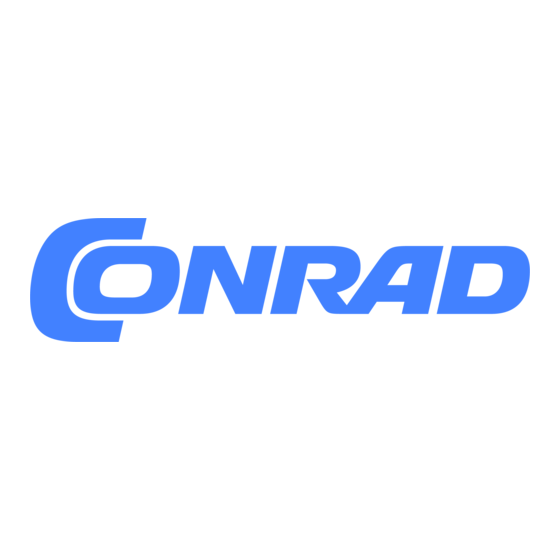
Advertisement
Quick Links
Advertisement

Summary of Contents for Conrad UKW
- Page 2 Art & Design, Composition: www.ideehoch2.de ISBN 978-3-645-10057-1 Produced on the order of Conrad Electronic SE, Klaus-Conrad-Straße 1, D92240 Hirschau All rights reserved, including the rights of photo-mechanical reproduction and storage in electronic media. Generation and distribution of copies on paper, data carriers or online, in particular as PDF, is only permissi- ble with the express consent of the publisher;...
-
Page 3: Table Of Contents
UKW Retro Radio The UKW Retro Radio Components Installation of Control Elements Soldering First Test and Settings Reception Practice Explanations on the Circuit Diagram... -
Page 4: The Ukw Retro Radio
The UKW Retro Radio This state-of-the-art VHF radio with traditional design receives FM stations in the range of 87.5 MHz to 108 MHz with good reception performance. You will mainly hear the strong local stations with good sound. However, the receiver is sensitive enough to also receive remote stations at times. -
Page 5: Components
With the highly integrated receiver IC TDA7088, construction of a dedicated VHF radio has become so simple that anyone is able to successfully solder together this radio. The single-ended low frequency amplifier works similar to the historic tube radio template. Your nostalgic radio uses a two-level transistor amplifier with medium volume at low battery voltage. -
Page 6: Installation Of Control Elements
Assembly of the Control Elements The radio has two rotary controls. One for frequency and one for volume. The volume controller with three connections additionally also carries the on/off switch with two connections. If you turn the axis all the way to the left, the switch opens. - Page 7 Speaker Screw the solder eye to the base of the telescopic aerial. Then push the aerial through the casing opening from the inside and push the end into the flat holder, which you have to attach properly in the casing with the included adhesive tape. The aerial is then installed sufficiently firmly, but can later be additionally at- tached with some adhesive tape.
-
Page 8: Soldering
Soldering The PCB already contains many soldered-on SMD components (surface-mounted device): the receiver IC TDA7088, 15 capacitors and one resistor. Only a few of these components still must be soldered in with connection wires. This includes all components of the NF amplifier, the coils and components around the radio’s diode tuning. - Page 9 Both coils must be made of the included equipment wire. Each of them has three turns with an inner diameter of 5 mm and a length of approx. 7 mm. Use the 100-µF-Elko as a coiling mandrel. First wind three turns close to each other. Then draw the turns apart so that the coil has a total length of approx.
- Page 10 The varactor diode D1 Now solder in the electrolyte capacitator C15 (100 µF). Observe installation direc- tion. The plus pole is marked on the PCB. The minus pole is marked with a white dash. It points towards the IC. Then install the ceramics of the capacitator C17 with 100 nF (print: 104).
- Page 11 The PCB completely equipped Next, solder on the matching wire pieces for the two potis. For their lengths, see the wiring plan. Either push the wire ends through the holes and solder them on like the remaining components, or solder them to the solder areas flat. The PCB should be installed suspended between the two potis.
-
Page 12: First Test And Settings
The complete wiring The radio is now assembled completely and can be tested. Draw the set-up with your name and date in the circuit diagram on the last page of these instructions. Then copy or tear out the page and glue it into the radio casing. This will make it possible to understand everything even after years and to perform repairs if they become necessary. -
Page 13: Reception Practice
For fine tuning, push a screwdriver between two turns to bend them apart a lit- tle. When the lower band threshold is perfectly adjusted, you can also adjust the upper threshold of 108 MHz. The frequency depends on battery voltage, how- ever. - Page 14 and the higher the reception frequency. The only tuning point is coil L1 to set the lower threshold of the oscillator frequency. The low frequency end stage is a simple class-A amplifier with the two transistors T1 and T2. Quiescent current is approx.


Need help?
Do you have a question about the UKW and is the answer not in the manual?
Questions and answers